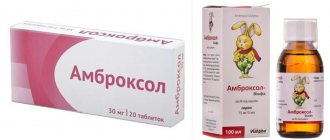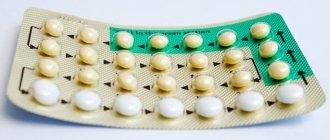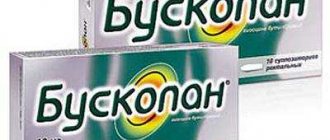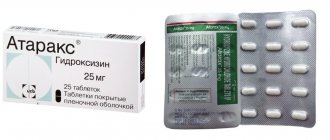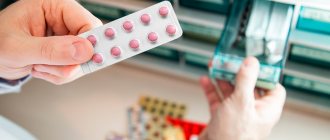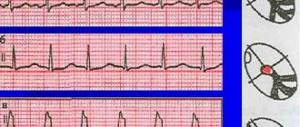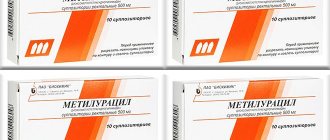Manufacturer
Nitroxoline tablets are familiar to many. They are often prescribed in cases of uncomplicated course of various diseases of the genitourinary system.
This raises the question: what is the difference between “Nitroxoline” and “Nitroxoline UBF”? In this case, the abbreviation UBF means the manufacturer - the Russian OJSC Uralbiopharm. Otherwise, both drugs are similar and have the same amount of active ingredient (nitroxoline).
According to indications and contraindications, these drugs are absolutely identical; the difference may be in the color of the tablet shell (yellow, yellowish, orange), in the appearance of the package and in the number of tablets in it.
Release form, composition and packaging
It is important to know that Nitroxoline is produced in one single dosage form, namely tablets for oral use. They have a biconvex shape, are covered with a shell, and are colored yellow-orange or orange. The drug is sold in packages of ten, twenty-five, thirty, forty, fifty, one hundred pieces.
The active ingredient is nitrocoline; each tablet contains fifty milligrams. Auxiliary ingredients include: starch, red dye, gelatin, sugar, lactose and silicon dioxide.
Nitroxoline Lekhim
Group Antimicrobial agents for systemic use Active ingredient: Nitroxoline General characteristics Composition of the medicinal product: active ingredient: nitroxoline; 1 tablet contains nitroxoline 0.05 g; excipients: lactose, potato starch or corn starch, talc, magnesium stearate, aerosil, granulated sugar, povidone 25, titanium dioxide, food gelatin, basic magnesium carbonate, macrogol 6000, tropeolin O, acid red 2 C. Dosage form. Coated tablets. Pharmacotherapeutic group. Antimicrobial agent. Pharmacological properties. Exhibits a bacteriostatic effect. Active against a number of gram-positive bacteria - staphylococci (including Staphylococcus aureus), streptococci (including beta-hemolytic streptococci, enterococci), corynebacteria, gram-negative bacteria - Neisseria, Escherichia coli, Proteus, Klebsiella, Salmonella, Shigella , enterobacteria, some other microorganisms - mycobacterium tuberculosis, trichomonas, and some fungi. After oral administration, it is quickly and completely absorbed from the gastrointestinal tract. It is excreted unchanged by the kidneys, with high concentrations formed in the urine (100 mcg/ml and above).
Indications.
Urinary tract infections (pyelonephritis, cystitis, urethritis, prostatitis, prevention of infections after operations on the kidneys and urinary tract), epididymitis, infected adenoma or carcinoma of the prostate gland. Contraindications. Increased individual sensitivity, incl. to 8-hydroxyquinoline derivatives, severe renal failure (oliguria, anuria), liver failure, glucose-6-phosphate dehydrogenase deficiency, cataracts, pregnancy, lactation (breastfeeding must be stopped during treatment).
Cautions for use.
Before starting treatment, consult your doctor! Patients with renal failure (under the control of the functional state of the kidneys) take Nitroxoline with caution due to the possibility of accumulation of the drug in the body. It is not recommended to take the drug for patients with diseases of the peripheral nervous system and optic nerve. Interaction with drugs. When used simultaneously with drugs of the tetracycline group, a summation of the effects of each drug is observed, and with nystatin and levorin - a potentiation of the effect
You cannot combine nitroxoline with nitrofurans to avoid a negative neurotropic effect. Features of application. During treatment with Nitroxoline, urine becomes saffron-yellow.
Method of administration and dose.
Inside, during meals, with a sufficient amount of water. Adults – 100 mg (2 tablets) 4 times a day, maximum daily dose 800 mg. Children - up to 5 years - 50 mg (1 tablet), 5 years and older - 50 - 100 mg (1 - 2 tablets) 4 times a day. The course of treatment is 2 – 3 weeks. Repeated courses are carried out with a 2-week break. To prevent infections during operations on the kidneys and urinary tract - 100 mg (2 tablets) 4 times a day for 2 - 3 weeks. In case of overdose, the side effects of the drug may increase. If any undesirable effects occur, you should temporarily stop using the drug and immediately consult a doctor. Side effects. Dyspeptic symptoms, nausea, vomiting, skin allergic reactions, general weakness, tachycardia, ataxia, headache, paresthesia, polyneuropathy. These phenomena usually disappear after discontinuation of the drug. If any undesirable reactions occur, consult your doctor regarding further use of the drug. Expiration date. 4 years. The drug should not be used after the expiration date indicated on the package. Storage conditions. Store in a dry place, protected from light, at a temperature not exceeding 25 0C. Package. 10 tablets in a blister pack. 5 contour blister packs in a cardboard pack. Vacation rules. On prescription.
Read/leave a review about the drug Nitroxoline
Pharmacological properties
The drug contains 14 different compounds, but the main active ingredient that exhibits activity is nitroxoline (50 mg/tablet). Its properties are due to:
- The ability to form enzyme complexes that provide the process of blocking and suppressing molecular synthesis and replication in bacterial cells, stopping the process of their reproduction.
- Reduced synthesis of membrane cellular proteins and catalyzing intracellular endoenzymes.
- Violation of redox processes in bacterial cells.
- Selective property - an exceptional effect only on pathogenic flora, without having a negative effect on the body.
- The ability to reduce adhesion (sticking) of uropathogenic flora to the epithelial layer of the urinary system.
There is rapid absorption of the drug in the gastrointestinal tract and 90% of its bioavailability (absorption capacity). When taken orally, the highest concentration of the active substance in plasma is observed within 1.5–2 hours. A large amount of it is localized in urine. It is excreted from the body mainly by the kidneys and bile (up to 5%).
How it works, indications, contraindications
The product works by blocking the connection of nucleic acids of microbial cells. This is possible due to the fact that nitroxoline forms compounds with those microbial enzymes that contain metal: they provide the process of nuclein synthesis. If deoxyribonucleic acid is blocked, the parasites can no longer reproduce. The microbial cell continues to live, but does not reproduce, which means the population of microbes ends. Since the structure of the enzymes that ensure DNA replication in the microbes themselves and in human cells is different, the drug acts selectively and destroys exclusively microorganisms that carry diseases, but does not have a negative effect on our tissues and organs. The drug copes well with gram-positive bacteria:
- Staphylococci (eg aureus);
- Streptococci (hemolytic, faecalis)
- All kinds of bacilli;
- Corynebacterium spp.
It also affects gram-negative microbes, including Klebisella, Shigella, Salmonella, Proteus spp., Enetrobacteria, Escherichia coli. It also destroys gonorrhea pathogens and microorganisms such as mycobacterium tuberculosis and Trichomonas vaginalis. It has a detrimental effect on some types of fungi, for example, dermatophytes, mold, candida and other pathogens of mycoses). So nitroxoline is effective for cystitis and many other ailments. It is actively used for the treatment of pyelonephritis, epididymitis, urethritis, as well as for the prevention of infectious diseases during catheterization, operations on the genitourinary tract and kidneys, and cystoscopy). It can also be used for inflammation in the prostate tumor (caused by carcinoma or adenoma).
Indications and contraindications for taking pills
The presence of indications for the use of Nitroxoline can only be determined by a urologist after carrying out all the necessary diagnostic procedures. The medicine can be used not only to treat a particular pathology of the urinary system, but also to prevent its development. This is especially true in cases where there has been mechanical damage to the bladder, kidneys, etc.
The tableted drug Nitroxoline is indicated for use in acute and chronic forms:
- pyelonephritis;
- cystitis;
- urethritis;
- epididymitis;
- prostate carcinoma.
Also, with the help of this drug (only under the close supervision of the attending physician!), preventive measures are carried out aimed at restoring the body after:
- catheterization;
- cystoscopy;
- surgical interventions in the organs of the urinary system.
The dosage is prescribed individually for each patient, based on his age, severity of the disease and the presence of concomitant pathologies.
Since Nitroxoline has a fairly strong effect on the functioning of the kidneys and liver, it has a large number of contraindications for use. Thus, when prescribing treatment for a particular disease of the urinary system, the doctor must take into account the presence of:
- chronic renal failure;
- cataracts;
- diseases of the central nervous system;
- liver dysfunction;
- individual intolerance.
As for whether it is possible to give Nitroxoline tablets to children, it is prescribed only in extreme cases, and is used under the supervision of the attending physician.
This medicine should not be used to treat urinary tract infections while undergoing therapy aimed at treating any other diseases not related to the kidneys, bladder, etc. This may cause serious side effects.
Despite the fact that this drug can pose a serious health threat, patient reviews of it are mostly positive. People who have previously suffered from urinary tract infections note the reasonable price of the drug and its rapid effect on the source of the disease. In addition, former patients claim that side effects from the use of Nitroxoline are extremely rare if all the instructions of the attending physician were strictly followed.
How to take Nitroxoline for cystitis?
Treatment of cystitis takes a lot of effort and time. For successful treatment, a remedy is required that can fight against microbes and relieve inflammation. Such a drug for cystitis is Nitroxoline. The remedy will not only relieve the disease, but also prevent possible relapses.
Instructions for use
Release form
The product is made from nitroxoline, which belongs to the class of hydroxyquinoline substances. To date, the only form of release of the drug is tablets intended for oral administration.
There is no need to look for the drug in the form of a powder or ampoules for injections, since the only certified form is tablets. The shape of the produced tablets is a biconvex structure with a characteristic yellow-orange color.
In addition to this substance, the composition also includes elements that perform an auxiliary function, such as:
- potato starch and lactose additive;
- talc and magnesium stearate;
- corn starch and sugar;
- povidone-25;
- colloidal silicon dioxide and titanium;
- magnesium carbonate and gelatin;
- red acid dye 2C;
- tropeolin O and Makrolog 6000.
In pharmacies you can find the drug in quantities of 10, 25, 30, 40, 50 and 100 pieces. The manufacturer has endowed each tablet with an active substance - 50 mg of nitroxoline.
Some manufacturers, in order to emphasize the fact that the drug was produced at a certain plant, add additional words to the name, but often, in terms of the degree of impact on the body, this is the same drug Nitroxoline.
The product has an inhibitory effect on the synthesis of bacteria and eliminates them. The body also has an effect on fungal structures and Trichomonas. The drug has a high absorption effect and is excreted in the urine.
Indications for use
The main indication that prompts the doctor to prescribe this remedy is the presence of an inflammatory process in the organs located near the urine excretion pathways.
Nitroxoline is an effective remedy for combating many types of bacteria and fungi, which is why it is often prescribed to combat cystitis. The main feature of this product is the destruction of pathogenic bacteria that multiply in the urinary tract and provoke an inflammatory process.
This medicine is used to reduce inflammation in the urinary tract and eliminate pathogens. This remedy is prescribed for:
- Inflammation in the area of the bladder and urethra.
- Pyelonephritis.
- Epididymitis.
- Urethritis.
- Benign diseases arising in the prostate gland.
The drug is used not only for acute cystitis, but also for the prevention of this disease during the commission period.
The drug is often used to prevent complications during surgical interventions in the urinary tract and kidneys. Sometimes it is taken during cystoscopy and catheterization.
To treat cystitis, our readers successfully use Galina Savina’s method
This cheap odorous remedy will get rid of cystitis forever! Sold in every pharmacy, called...
If we take into account people’s reviews about the effectiveness of treating cystitis and other diseases, we can say with confidence that this remedy is one of the most effective.
Contraindications
Despite the positive effects on the body, the product has negative consequences, manifested in the above symptoms. Therefore, it is important to remember the following contraindications:
- liver-related diseases;
- cataract;
- acute renal failure;
- child's age up to three months;
- period of breastfeeding (lactation);
- pregnancy;
- ulcer in the gastrointestinal tract;
- individual intolerance to the components included in the product.
Side effects
The tablets are intended to be swallowed whole with a specified amount of water.
After use, nausea and dizziness may occur, so taking the tablets on an empty stomach is not recommended. It is better to take the medicine with food.
You should not be surprised if during the treatment period the color of urine may change to red-yellow.
Studies have shown that side effects after taking Nitroxoline manifest themselves in the appearance of a rash on the skin, itching and headache. The drug can affect a person’s balance and nervous state, and they may also experience dizziness.
Dosage for cystitis
Before you start taking it, you need to read the instructions located in the packaging of the drug. The tablet should not be kept in the mouth for a long time and dissolved, because such actions can significantly reduce its effectiveness. The product must be swallowed and washed down with a glass of clean water.
If you take Nitroxoline during meals, then you can avoid unpleasant consequences from the body.
Dosage adjustments should only be carried out by a qualified physician.
The treatment regimen will depend on the course of the disease and the studies performed prior to treatment. If an effective effect is not observed within several days, the doctor may increase the dose taken.
After completing the full course of treatment, the patient will be asked to take a urine test, which will reflect the results. The course of treatment can be resumed if the tests are sharply deviated from the norm. In this case, the treatment can be carried out again, but with an interval of two weeks.
The course of treatment often lasts up to three and sometimes four weeks. The dose of the drug taken should not exceed 0.8 g. Usually no more than 0.4 g per day is prescribed.
How to take Nitroxoline for children?
The possibility of children taking such a drug should only be determined by a doctor. He also adjusts the dose based on the child's age and condition. In standard cases, the dose prescribed for a child is 0.2 g per day, usually divided into several doses.
Read about the symptoms and treatment of cystitis in children in our article.
For children over the age of five, the attending physician may slightly increase the dose.
The course of treatment, as in adults, is about fourteen days.
Use during pregnancy and lactation
There have been no studies conducted on the interaction of the drug during pregnancy, but the manufacturer warns not to use this drug while expecting a child.
If there is a question about the threat to the mother’s life without the use of any treatment, the question should be considered only by a doctor, who should be guided by the fact that the first and last trimester are especially important for the expectant mother and fetus.
The drug Nitroxoline is strictly prohibited for women who are breastfeeding.
Interaction with other types of drugs
It is important to know that when taking this drug together with others, it is necessary to adjust the doses, otherwise the effect on the body of one of them may have a detrimental effect due to an increase in the effect.
For example, if you take this drug simultaneously with nitrofurans, then a negative effect will be had on the nervous system, which will lead to further complications. If taken with tetracycline preparations, their mutual effect is enhanced.
Analogues of the drug
Nitroxoline, like many other medicines, has similar drugs - synonyms and analogues. Synonym drugs are usually called those active agents that are produced on the basis of nitroxoline (a derivative of 8-hydroxyquinolone).
Medicines with similar effects include drugs based on similar substances, but with similar purposes and uses. Synonymous means include:
- 5-NOK;
- 5-Nitrox;
- Nitroxoline-Acos;
- Nitroxoline-UBF.
Analogues can be considered such means as:
- Amizolid. The substance actively fights microbial effects on the body and eliminates them. Relieves inflammation and its symptoms.
- Dixin. Can be used as a solution for oral and external use. Used to prevent inflammation of the urinary system and when using a catheter.
- Zenix. Available in tablet form. Eliminates the inflammatory process and acts against the proliferation of microbes, having a detrimental effect on them.
Differences between Nitroxoline-UBF and 5-NOK from regular
The composition of regular Nitroxoline and Nitroxilin-UBF are the same, as well as their properties and contraindications. The only difference between Nitroxilin-UBF is that the permissible dosage declared by the manufacturer is 1.1-1.2 g. Everything else for these two drugs is absolutely the same.
The product 5-NOK contains the substance nitroxoline and has the same effects as Nitroxoline. In terms of the degree of impact, it is at the same level, the only difference is that 5-NOK is much more expensive in cost. Therefore, many people prefer Nitroxoline.
Nitroxoline - instructions for use:
Drug incompatibility
How to take Nitroxoline while using other medications? It should not be used together with antacids, which are often prescribed for gastritis or peptic ulcers. These drugs significantly reduce the bioavailability of the drug, which impairs its effectiveness. Nitroxoline is incompatible with drugs from the hydroxyquinoline group, which are used for protozoal infections (amoebiasis). It should not be used with nalidixic acid (an antibacterial agent from the quinolone group), as its effectiveness is significantly reduced. For the treatment of diseases of the urogenital system, nitroxoline is prohibited from being combined with nitrofurans.
Substitutes by principle of action
Nitroxoline has a number of more modern analogues (drugs with action against the most common pathogens of cystitis):
Nitrofuran derivatives (“Furamag”, “Furagin”, “Furasol”). They are the drugs of choice for the treatment of acute cystitis. Well tolerated by patients. The frequency of side effects is much lower than that of nitroxoline. The starting duration of treatment is 3 days
However, nitrofurans are used with caution in diseases of the kidneys, lungs and diabetes. Fosfomycin (“Monural”, “Phosfural”) is a derivative of phosphonic acid. Recommended for use in cystitis by international recommendations
Fosfomycin is effective against Escherichia coli, Proteus, and Klebsiella. In the acute phase of the disease, a single use of the drug is sufficient. It is also better tolerated. There are numerous studies that convincingly show the effectiveness of the drug for urogenital infections. Penicillins. This group of natural antibiotics with a wide spectrum of action against bacterial pathogens. For urogenital infections, amoxicillin with clavulanic acid is most often prescribed. Used when fosfomycin or nitrofuran is ineffective. It is well tolerated by most patients, but allergic reactions are possible. Fluoroquinolones. This is a group of antibacterial agents whose mechanism of action is based on blocking the enzyme DNA gyrase, which leads to the death of pathogenic pathogens. The drugs are excreted in active form in the urine, which allows them to be used for the treatment of cystitis. They should not be used during lactation or pregnancy.
Azithromycin for cystitis
It is known that most often inflammation of the bladder tissue occurs due to infection entering the organ. In such a situation, doctors use antibacterial drugs to treat cystitis in their patients. In case of non-infectious disease, antibiotics are not needed. However, we are not able to diagnose cystitis on our own, so if the doctor prescribed you Azithromycin, it means that your body is unable to independently cope with bladder inflammation caused by microbes. In such situations, antibacterial therapy is one of the most effective ways to solve the problem of cystitis.
Today we want to talk about the features of the treatment of this disease with the use of Azithromycin. Is this drug effective in treating cystitis? How to use it correctly? Does this antibiotic have any contraindications? You can find comprehensive answers to all these questions in our article.
Have you been fighting CYSTITIS for many years without success?
Head of the Institute: “You will be amazed at how easy it is to cure cystitis by taking it every day...
Read more "
Pharmacological properties of the drug
Azithromycin belongs to the group of macrolide antibiotics with a wide spectrum of antibacterial action. The active substance of the drug is azithromycin dihydrate. The medicine is produced in the form of tablets of 250 and 500 mg.
The pharmacological action of Azithromycin is based on blocking the production of vital protein in bacteria. This drug destroys infections caused by streptococci, staphylococci, Haemophilus influenzae, Moraxella, Bordetella, Neisseria, Helicobacter pylori bacteria and other pathogens.
This medication has found its use in the treatment of infections of the genitourinary system: prostatitis, cystitis, pyelonephritis, urethritis, vaginitis, endometritis, chlamydia, gonorrhea, mycoplasmosis and other pathologies. It is also used in the treatment of infectious diseases of the respiratory system and ENT organs, skin, and peptic ulcers. Consequently, Azithromycin has a wide spectrum of action against pathogens of various infections, so it can be called one of the most effective antibacterial agents used to treat internal inflammatory processes.
Instructions for use
In the treatment of acute and chronic bacterial cystitis, the dosage of the drug is selected by the doctor. As a rule, children under 12 years of age are prescribed Azithromycin 1 tablet (250 mg) once a day. The course of treatment takes three days. In complicated forms of cystitis that have led to the development of pyelonephritis, the dosage of the drug can be doubled (500 mg per day). The capsule should be taken on an empty stomach with plenty of water.
Contraindications and side effects
Azithromycin is not prescribed for the treatment of cystitis and other infectious diseases for people with liver and kidney failure, allergies to the components of the drug, and women during pregnancy and breastfeeding.
Side effects of Azithromycin are quite extensive, but are rare. During treatment with this drug, there is sometimes a decrease in the number of platelets in the blood, causing a tendency to bleed. Increased nervousness, anxiety, and insomnia may also occur. Side effects of the drug include ringing and noise in the ears, headache and dizziness, arrhythmia, bloating, vomiting and nausea. It is extremely rare that during treatment with Azithromycin, pain in the joints appears, inflammatory changes in the kidneys, and fungal infections of the intestines and vagina are observed.
In case of an overdose of Azithromycin, the following clinical picture occurs: temporary hearing loss, diarrhea, vomiting, nausea. In such a situation, it is necessary to stop the medicine and rinse the stomach.
Analogues of Azithromycin are drugs such as Azitsin, Sumamed, Zomax, Azitral, Azitrox, Zitrox, Sumametsin, Azax.
Conclusion
So, we found out that the antibiotic in question has a wide spectrum of action, so it is prescribed for the treatment of bacteriological cystitis.
However, you cannot take this drug without permission, since it has a number of contraindications and side effects. Based on this, we can conclude that treatment of cystitis with antibiotics should be trusted to experienced urologists. Be healthy!
Adverse reactions
Instructions for use for cystitis contain information about the following possible side effects:
- dyspeptic disorders (aching abdominal pain, feeling of heaviness in the epigastrium, vomiting, nausea, loss of appetite, burning sensation in the chest or heartburn);
- local or general allergic reactions (skin rash, anaphylactic reactions);
- aching headaches;
- dizziness;
- blurred vision due to optic nerve neuritis;
- parasthesia (feeling of crawling, impaired peripheral sensitivity);
- pain in peripheral muscles;
- tachycardia (increased heart rate).
An additional danger lies in the neurotoxic effect of the drug. The scientific literature describes cases where, with long-term use of nitroxoline, subacute peripheral neuropathy developed, which is manifested by flaccid paralysis, sensory disturbances and autonomic disorders. Tolerability of the drug is individual. The most common disorders are those of the digestive system. Most side effects are dose-dependent and disappear quickly after discontinuation of nitroxoline. Therefore, it is also necessary not to exceed the prescribed dose of the medicine.
It is strictly forbidden to drink alcoholic beverages, since their combination with nitroxoline leads to an increase in side effects (primarily dyspeptic symptoms and myalgia).
Instructions for use on Nitroxoline tablets
The use of any drug is possible only if prescribed by a doctor. Only a competent specialist will tell you what dosage you need personally and what dosage for children. The instructions for use of Nitroxoline tablets for cystitis included in the package contain the following information:
- short description;
- pharmacology;
- release form;
- dosage;
- side effects;
- indications;
- contraindications;
- application features.
The instructions for Nitroxoline for cystitis are understandable to a person without medical education. It states that if symptoms of cystitis appear, take 2 tablets four times a day for up to two weeks. Nitroxoline for cystitis in women should be taken at an equal time interval of 5-6 hours.
It is imperative to drink Nitroxoline for cystitis with clean still water to avoid an accidental chemical reaction of the medications. Children are allowed to take Nitroxoline from the age of three months. Calculate the dose according to the baby's weight.
Pregnant and breastfeeding women should consult their doctor and not put the health of their unborn child at risk. No studies have been conducted on the effects of the drug on the fetus and it has not been clinically proven.
Take Nitroxoline until urine tests show positive changes. Take urine tests at the beginning of treatment, midway while taking the medication, and after completing the course.
Analogs, where to buy and price of Nitroxoline
You can buy Nitroxoline without a prescription at any nearby pharmacy. The price varies from 50 rubles to 229 rubles per package. If the cost is high for you, then, in agreement with your doctor, you can choose an analogue of Nitroxoline. The drug has two analogues for the active substance:
Video playlist about cystitis (video selection in the upper right corner)
How to use
The method of taking Nitroxoline is oral. The frequency of administration and dosage depends on the disease and is prescribed by a doctor. The instructions should not be ignored.
If it is not possible to buy Nitroxoline, analogues act in a similar way:
Nitroxoline for cystitis is taken four times a day. The course of treatment is 14 days
It is important to note that a break between taking each tablet is desirable for at least 6 hours. Take the medicine an hour before meals with a glass of water, cranberry juice or milk.
Children are prescribed a dose according to their body weight. If you miss a dose, take the pill quickly and under no circumstances increase the dose. If there is no positive result, the course of treatment with Nitroxoline is extended by 3 days. After therapy, it is necessary to do a urine test. The doctor will determine the need for re-treatment with the drug after a break of 2 weeks. If the tests that must be taken within 3 days are normal and the symptoms of the disease have disappeared, stop taking the drug.
How to use the drug correctly
Before starting to take the drug, you should consult your doctor.
When treating acute cystitis, the medication must be taken 4 times a day for 2 weeks. The interval between taking the drug should be at least 6 hours.
After eliminating the symptoms of the disease, it is necessary to continue taking the medication until the urine test results are normalized.
If the medication is used to treat a chronic form, then it should also be taken 4 times a day. The maximum daily dose of tablets is 20. If the use of the drug does not bring the desired results, then the course of taking it is extended to 3 weeks.
If the tests do not return to normal, the specialist may prescribe a two-week break, after which it will be necessary to continue treatment.
The medication is a small yellow coated tablet. They must be taken orally. It is best to take this medication during meals or immediately after. Nitroxoline should be taken with a small amount of liquid.
This drug interacts with alcohol for quite a long time. It is best to consult a specialist when determining the volume of the drug. The doctor will determine the required dosage based on the general condition of the body and the form of the disease.
When taking Nitroxoline, your urine may change color. It may take on a yellow-red or orange tint. This reaction is completely natural for the body. Reviews confirm this reaction of the body to the pills.
Analogs
You can replace nitroxoline with many drugs that are similar in their spectrum of action and therapeutic effect, but with a different active substance. They can be in the form:
- Tablets for oral administration - amizolid, zenix, zyvox, hexamethylenetetramine, monural, sanguiritrin.
- Powder for preparing a solution for intravenous and intramuscular injections - dixin, dioxidin, kirin, urophosphabol.
- Tinctures – galenophyllipt and eucalyptus.
If therapeutic treatment is necessary, its main component is a rational choice of drugs. Regardless of the price category, you should entrust your health to proven medicines - with studied pharmacokinetics and proven antimicrobial activity, confirmed by controlled clinical studies.
Indications for use
Cataract
Hypersensitivity to nitroxoline or to inactive ingredients
Severe liver failure
Hypersensitivity (including to other 8-hydroxyquinoline derivatives), renal dysfunction, accompanied by oliguria, anuria; severe liver diseases, cataracts, neuritis, polyneuritis, glucose-6-phosphate dehydrogenase deficiency, pregnancy, breastfeeding.
Contraindications include hypersensitivity to
or other components of the drug, as well as other quinolines, during pregnancy and breastfeeding, children under 3 years of age.
- Severe liver diseases;
- Renal dysfunction with anuria, oliguria;
- Glucose-6-phosphate dehydrogenase deficiency;
- Polyneuritis;
- Neuritis;
- Cataract;
- Pregnancy and lactation;
- Hypersensitivity to the drug or other 8-hydroxyquinoline derivatives.
Main characteristics
In ICD 10, nitroxoline is listed in the nosological classification of pathologies section under No. 12 in the extensive register of quinolines, which are antimicrobial drugs. In essence, it does not belong to the class of antibiotics. It appeared in clinical practice more than 40 years ago as a drug with a wide spectrum of action, which made it possible to prescribe it, mainly in the treatment of bacterial and fungal pathologies caused by:
- various types of staphylococci and streptococci;
- pathogenic varieties of Escherichia coli and diphtheria coli;
- gonococci, Protea and Klebsiella;
- salmonella, shigella and trichomonas;
- a large family of enterobacteria and mycobacterium tuberculosis;
- various types of fungi (Candida, dermatophytes, molds).
Nitroxoline is not produced abroad, considering it a low-effective product for which there is an excellent modern, higher-quality replacement. Its production is carried out only by domestic pharmaceutical companies and only in tablet form, adding to the name of the drug their own special distinctive sign indicating a specific manufacturer - Nitroxoline UBF, “Nitroxoline AKOS” and other prefixes that do not affect the composition of the drug.
Other drugs used in the treatment of cystitis:
- Flemoxin.
- 5 nov.
- Ciprofloxacin.
- Analogues of Monural.
General characteristics of the drug
If you have been prescribed nitroxoline, is it an antibiotic or not - the first question that you will probably have. The fact is that pharmaceutical companies producing the drug often add the abbreviation of their production to the name to give the drug “authority.” However, no matter what words are used, nitroxoline remains a drug with a fixed content:
- magnesium stearate;
- silicon dioxide and titanium;
- magnesium carbonate;
- tropeolin O;
- macrogol 6000;
- potato and corn starches;
- lactose, talc, granulated sugar and red dye 2C.
Nitroxoline is not an antibiotic, although, like them, it has an antimicrobial effect. The difference lies in the degree of impact on microorganisms: with antibiotics it is more radical, so the microbes needed by the human body also fall under its influence.
If you have been prescribed nitroxoline, you need to know what these tablets are for. This drug is indicated for patients:
- with infectious or other diseases of the urinary and genital tract, which are provoked by harmful microbes - with cystitis, urethritis, pyelonephritis;
- with an infected adenoma or other inflammation of the prostate gland;
- with epididymitis;
- for preventive treatment of the urinary tract;
- during postoperative restoration of the genitourinary system and kidneys.
About some features of Nitroxoline
For children, this drug is prescribed only after the attending physician has carefully developed a detailed treatment regimen. Under no circumstances should you deviate from the dosage, otherwise there is every chance of ending up in a hospital.
When making an independent decision to use this substance, you should carefully study the instructions for it.
As a rule, children aged 3-5 years take 0.2 g of the drug, and 1 dose of the drug should be divided into 4 parts. For young patients aged 5 years and older, the daily dosage is 0.4 g. The duration of the therapeutic course is 2-3 weeks.
To achieve the effect of treatment, it is necessary to take into account some nuances regarding what this drug can be combined with and what it absolutely cannot be combined with.
It is not recommended to use the medicine with:
- Nalidixic acid, since nitroxoline reduces the rate of absorption of this substance.
- Medicines based on nitrofuran due to increased stress on the nervous system, as a result of which the patient may experience severe side effects.
- Magnesium-based antacids, which impair the absorption of nitroxoline into the blood.
With antibiotics of the tetracycline group, this substance, on the contrary, enhances its effect. When combining these medications, their dosage must be reduced by half to avoid the development of allergic reactions or other side effects.
Drugs that, for one reason or another, can replace Nitroxoline are:
- Amizolid.
- Galenophyllipt.
- Hexamethylenetetramine.
- Zenix.
- Alcohol tincture of eucalyptus.
- Fosfomycin is a powder that is easily soluble in water and used internally.
Storage temperature should not exceed 15-25 degrees. If it is noticed that these conditions are violated, it is better to purchase new medications at the pharmacy so as not to risk your health or the health of your family!
Application for children
The dosage of the drug for children is calculated individually, taking into account the ratio of ten to thirty milligrams per 1 kilogram of weight per day. The received dose is divided into four doses. That is why, if the child weighs ten kilograms, then the daily dosage is from 0.5 to 1.5 tablets per day. Children under five years old take 1 tablet four times a day.
From five to fifteen years of age - two tablets 4 times a day, and over fifteen years of age, an adult dosage is used. The duration of the therapeutic course should be determined individually, but is generally 10-21 days. Do not take until symptoms are eliminated, but up to three urine tests, which will show the normal limit.
Efficiency in inflammation of the bladder
If you look at the latest European or domestic recommendations for the treatment of cystitis, nitroxoline is not there. But why did this happen? The problem is poor tolerability of the drug. Immediately after the start of clinical use, a large proportion of patients developed severe dyspeptic disorders (abdominal pain, nausea, vomiting and loss of appetite) and neurological symptoms. Therefore, gradually they began to abandon nitroxoline in favor of furagin, which was much better tolerated.
Another problem with the drug is the lack of independent multicenter studies that would convincingly demonstrate its effectiveness against genitourinary tract infections. Therefore, its use is possible only in situations where drugs from other groups (penicillins, cephalosporins, macrolides, fluoroquinolones) have shown poor effectiveness or are not available. In modern evidence-based medicine, nitroxoline plays a different role. About 10 years ago, an American study showed that the drug has a moderate cytotoxic effect against certain types of tissue. Therefore, there are prospects for using the drug in chemotherapy for cancer.
Side effects
When taking Nitroxoline tablets, the tongue, urine, and feces become bright orange. When using the drug for more than 10 days, a number of undesirable reactions are observed.
This:
- loss of appetite;
- nausea;
- vomit;
- stool disorder;
- stomach ache;
- cardiopalmus;
- headache;
- dizziness;
- muscle pain;
- weakness;
- polyneuropathy;
- liver dysfunction;
- allergic reaction in the form of rash, urticaria.
The most severe undesirable effect from taking Nitroxoline is the development of neuropathy. It begins with abdominal pain and stool disorder, then severe polyneuritis develops, leading to atrophy of the optic nerve.
After stopping the drug, all these unwanted reactions will disappear. For all severe manifestations, you should contact your doctor to adjust the line of therapy.
Contraindications and side effects
Therapy with Nitroxoline can provoke the development of side symptoms:
- nausea;
- vomiting and lack of appetite;
- dizziness;
- risk of liver dysfunction;
- skin rash and itching;
- headache and ataxia;
- neuritis of the optic nerves;
- paresthesia.
As for contraindications, it is strictly forbidden to take Nitroxoline in the following cases:
- for cataracts, neuritis;
- during lactation and pregnancy;
- in case of an allergic reaction to the composition due to individual intolerance;
- with chronic kidney and liver failure.
If the patient has a mild or moderate form of renal failure, then the drug can be taken under the strict supervision of a doctor.
Do not exceed a dosage of 800 milligrams, since Nitroxoline can accumulate in the blood as a result of a reduced rate of excretion by the kidneys, which can cause intoxication and overdose.
Principles of action of Nitroxoline
The antimicrobial effect of nitroxoline is to block the DNA of pathogenic microorganisms, due to which the infected cells die and further spread of the infection is blocked. A set of certain enzymes in the structure of the drug allows a selective approach to the destruction of pathogenic cells without having a negative impact on other tissues and systems of the human body. Here are the microorganisms that “succumb” to the effects of nitroxoline:
- staphylococci;
- streptococci;
- diphtheria bacillus;
- gonococci;
- Proteus;
- Klebsiella;
- Trichomonas;
- thrush;
- microbacteria tuberculosis;
- fungi related to molds;
- enterobacteria;
- Streptococcus hemolytic type beta.
Due to the wide spectrum of effects of the drug, nitroxoline is prescribed for any disease caused by a pathogen from this list.
Features of taking Nitroxoline for cystitis
Nitroxoline is often prescribed for cystitis. It is imperative to take into account the severity of the disease, because it determines the dosage of the drug and the effectiveness of treatment. If cystitis is acute and symptoms appear for the first time, then it is enough to take a course of two weeks, and it is recommended to take two tablets every six hours. Treatment is considered complete if the patient's urine test three times in a row does not contain pathogenic microorganisms.
For the treatment of chronic cystitis, nitroxoline is taken according to the same scheme. But, if the symptoms do not disappear, the dose is increased to six tablets per one-time dose every 12 hours. This treatment lasts three weeks, and then you need to take a detailed urine test. If the infection still exists, antibiotics are prescribed.
Antibiotic nitroxoline or not - in any case, it is a drug that is considered an effective means of getting rid of ailments of the urinary and reproductive systems. As a rule, the problem is successfully solved in one step. However, a number of patients complain about a rather long course of therapy. In addition, changes in urine color are sometimes noted. In each specific case, the patient’s attending physician should tell the patient in detail about possible side effects and how to take nitroxoline.
About the product
Nitroxoline is sold under the name 5-nok and belongs to the antimicrobial agents from the hydroxyquinoline group. This also includes the previously popular enteroseptol, mexaform and intestopan. Hydroxyquinolines have not been used in the USA and European countries for a long time, but in our latitudes 5-noc for cystitis in women (men too) is prescribed quite often.
Before taking nitroxoline for cystitis, it is worth clarifying only one thing: whether it is an antibiotic. In fact, doctors believe that hydroxyquinolones are not antibiotics at all and they are antimicrobial agents with serious side effects. Like all similar medications, nitroxoline tablets for cystitis should be taken with extreme caution and according to the rules.
Treatment of children
Since the liver in children is not mature enough and is vulnerable, many medications are not always absorbed by the child. Insufficient development of the kidneys, which do not remove the drug from the body in time, can provoke an overdose and poisoning. Therefore, the course of therapy with this drug in children is selected on an individual basis. If children do not have any health problems (neuritis, gastrointestinal problems), the standard course therapy protocol is used:
- In children under 6 years old – 50 mg (4 doses per day).
- From 6 to 16 years – 50 mg – 100 mg (4 doses per day).
- At an older age, the dose is adult.
The treatment course is standard – up to 3 weeks. Therapy ends when urine tests are normal three times.
Diseases for which it is used
Nitroxoline is an antibacterial drug whose action is aimed at pathogens of the genitourinary system.
- Cystitis is an infectious inflammatory disease of the bladder that occurs in women of any age. Anatomical features - a very short urinary canal, close proximity of the urethra to the rectum. This makes it easier for microbes to enter the bladder. The disease is accompanied by severe pain, burning, itching in the genital area, perineum, and frequent urination. Sometimes the disease may be accompanied by high fever.
- Urethritis is an infectious inflammation of the urethra in men and women. It occurs due to damage to the urethra by bacteria: staphylococcus, streptococcus and E. coli. Accompanied by a strong burning sensation that increases with urination. There is pain and the presence of blood in the discharge.
- Pyelonephritis is a disease caused by an inflammatory process in the kidneys. The origin is bacterial. It is more common in women due to anatomical features. Pyelonephritis can affect children and pregnant women. In most cases it is asymptomatic.
- Orchitis is an infectious inflammation of the testicles in men caused by bacteria. The affected organs increase in size and change their usual color to dark burgundy. The disease is accompanied by fever, chills, swollen lymph nodes, and severe pain.
- Epididymitis is inflammation of the epididymis. It can occur latently or with pronounced painful symptoms.
- Prostatitis is an infectious inflammation of the prostate gland. The pathology affects sperm production. Leads to infertility.
- Prostate adenoma and carcinoma is a disease that occurs in men after 40 years of age. Changes appear that represent growths of glandular tissue in the area of the bladder neck.
Instructions for use and dosage
Treatment with nitroxoline involves taking the drug 4 times a day at regular intervals. Single dosage – 2 tablets (100 mg). If necessary, it is possible to increase the dosage to 1 thousand mg/day (20 tablets), with the same 4 times a day and equal intervals.
There are no particular differences in the general treatment of urological pathologies and how to properly take nitroxoline tablets in the treatment of cystitis. The therapeutic course for acute urological pathologies is from 1.5 to 3 weeks. Recovery is considered to be the absolute relief of signs of the disease and compliance with normal laboratory parameters.
In case of a chronic, recurrent process, a treatment course with a standard dose of the drug can last up to 6 months. Course therapy – 3 weeks. The daily dose is 400 mg (8 tablets), followed by a 2-week break and continuation of treatment until clinical symptoms are completely relieved and laboratory urine values are normal. The same dosage of nitroxoline tablets is prescribed for chronic cystitis in the acute stage.
In case of successful therapy of the first course, and normal indicators of the control analysis, treatment can be considered complete. Otherwise, after a two-week break, therapy should be continued for another 3 weeks.
When preventing complications, standard therapy is carried out - 100 mg 4 times a day for one and a half to three weeks. Taking the drug does not depend on the timing of meals. The tablet should be swallowed whole with plain water (up to 100 ml).
How to take Nitroxoline correctly: instructions for use
The standard regimen for taking the drug requires adults to drink 2 tablets 4 times a day. The product should be taken at regular intervals, but not more than once every 5 hours. The course of treatment continues until complete recovery, during which the symptoms of the disease completely disappear and tests normalize.
It is better to take the medicine during meals or immediately after it, since using the drug on an empty stomach can cause nausea or even vomiting.
In acute forms of infectious diseases, the dosage is increased and 4 tablets are taken 4 times a day, and the duration of treatment is from 10 to 21 days.
Treatment of chronic diseases is carried out according to the standard scheme. The drug is taken for three weeks, after which a break is taken for two weeks. The maximum duration of the course with breaks should not exceed 6 months.
Use during pregnancy and lactation
According to the instructions, Nitroxoline is contraindicated for women during pregnancy and lactation. This is due to the fact that clinical trials of the drug were not conducted, for obvious reasons. However, many gynecologists prescribe the drug, since not a single case of its effect on the fetus or infants has been identified.
Reception by children
Nitroxoline is absolutely safe for children, as it is excreted from the body exclusively through the kidneys and does not affect other organs in any way. It is allowed to be taken from 3 months.
Brief conclusions
Nitroxoline is one of the effective remedies in the fight against genitourinary infections in men, women and children. It is not addictive and causes minimal harm to the body. The range of diseases and medical procedures that these tablets help with is quite extensive.
The course of treatment is 2 weeks, in some cases it increases to 21–24 days. Treatment is carried out as prescribed by the supervising doctor. The daily dose of Nitroxoline is 20 tablets. Improper use will lead to serious complications and harm to health.
The medication has a number of contraindications. Before use, consult your doctor and carefully read the instructions. Nitroxoline comes in the form of film-coated tablets.
At home, Nitroxoline can be used as an antiseptic for small purulent wounds:
- To do this, the tablet must be finely crushed.
- Sprinkle the resulting powder onto the affected area.
Treatment of genitourinary infections is a long and expensive process. If you follow all the doctor’s recommendations and take the medicine correctly, you can get rid of unpleasant symptoms and avoid complications.
Drug interactions
During simultaneous use with tetracycline antibiotics, the medicinal effect of both drugs (Levorin, Biomycin, Tetracycline, Nystatin and Doxycycline) may increase. That is why, if simultaneous use is unavoidable, the dosage is reduced by half.
Be sure to read:
Pulmicort for inhalation: instructions for use for children and adults
If Nitroxoline is combined with nitrofuran derivatives, then there is a risk of developing side effects from the central nervous system (Furadonin, Furacilin, Furazolidone, and Furagin). To prevent the development of complications, it is strictly forbidden to take such medications together.
You may be interested in an article about the healing properties and dangers of hop cones.
There is also a useful article about treating cystitis at home.
Here you will learn about possible causes and ways to eliminate pain in the tailbone.

